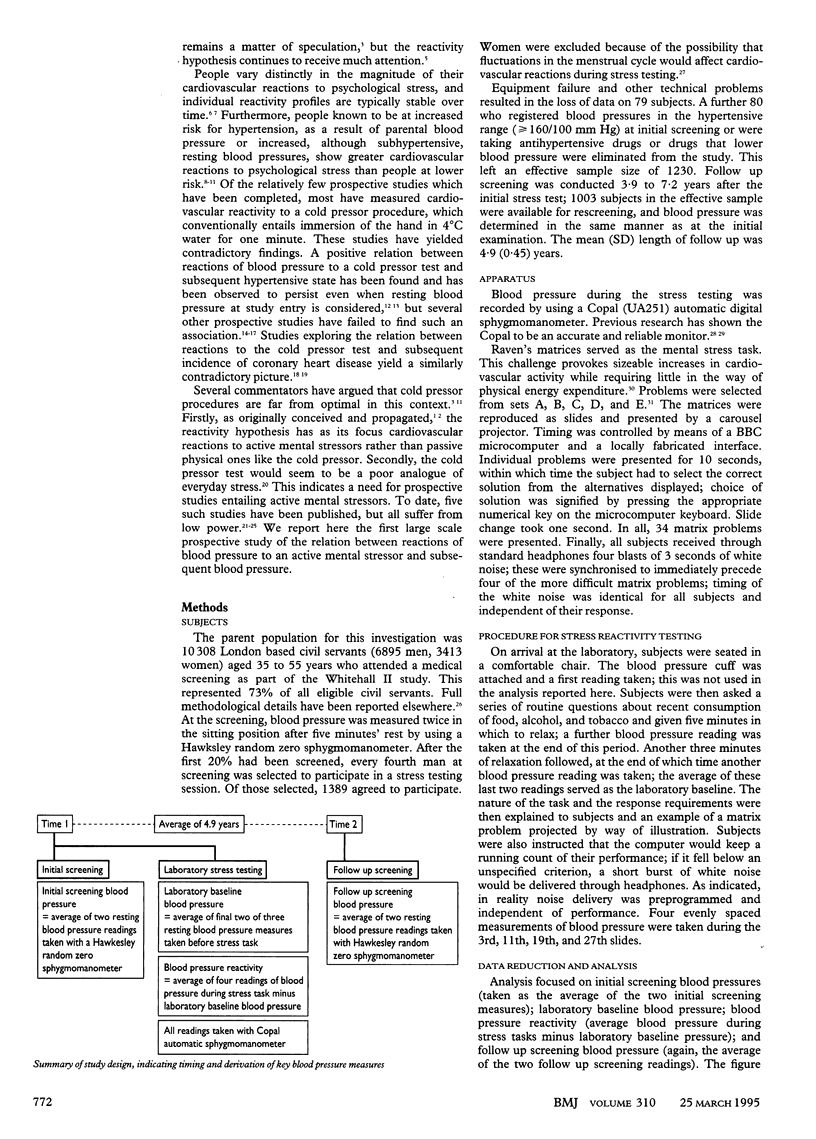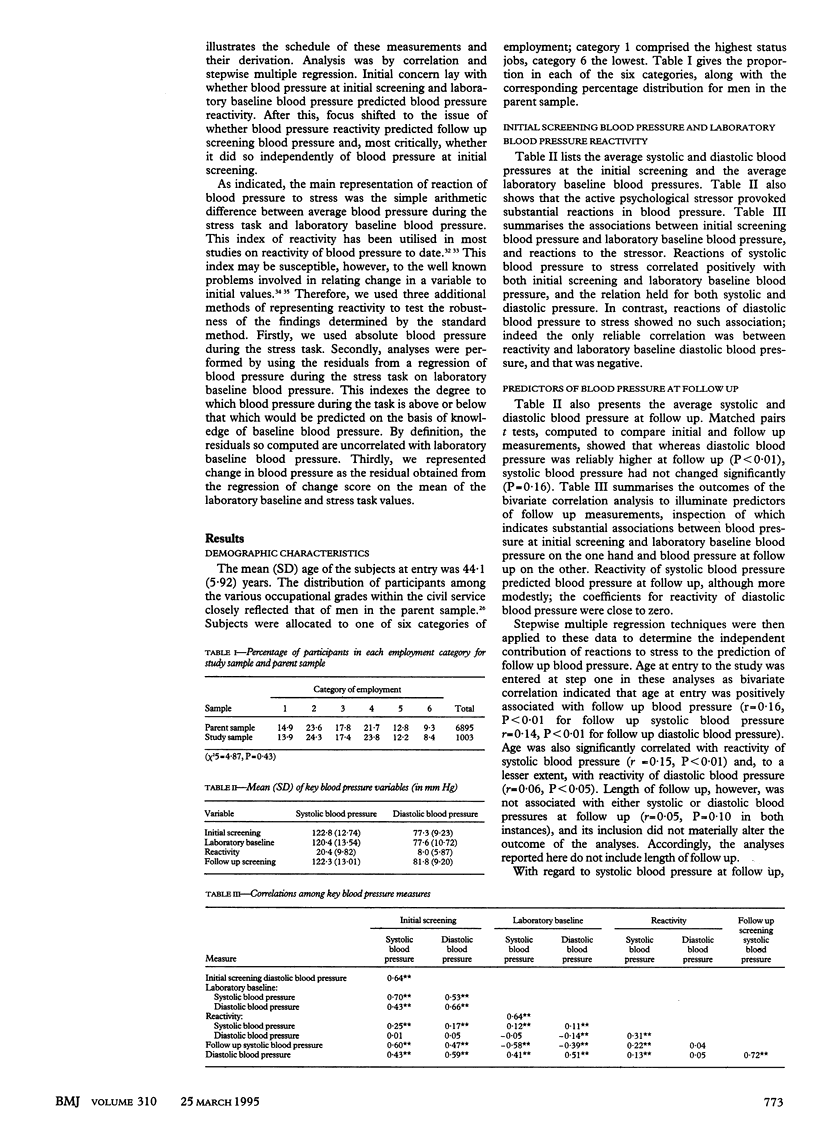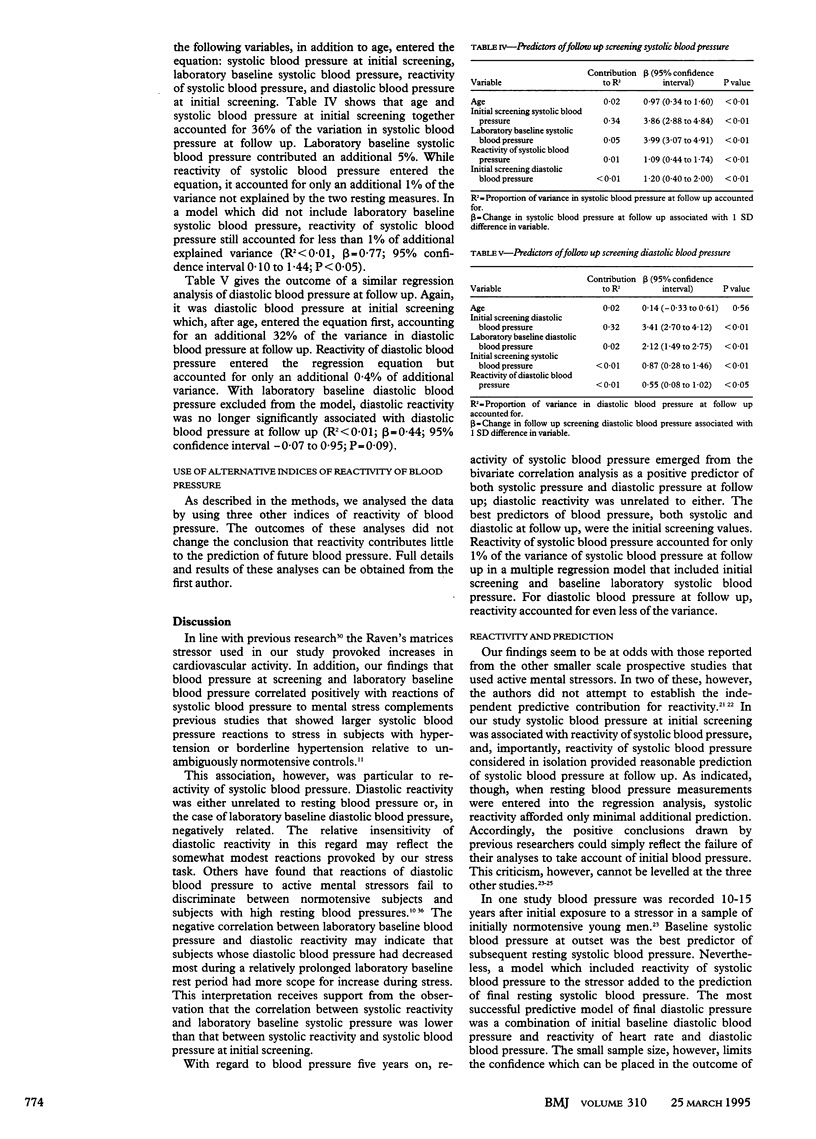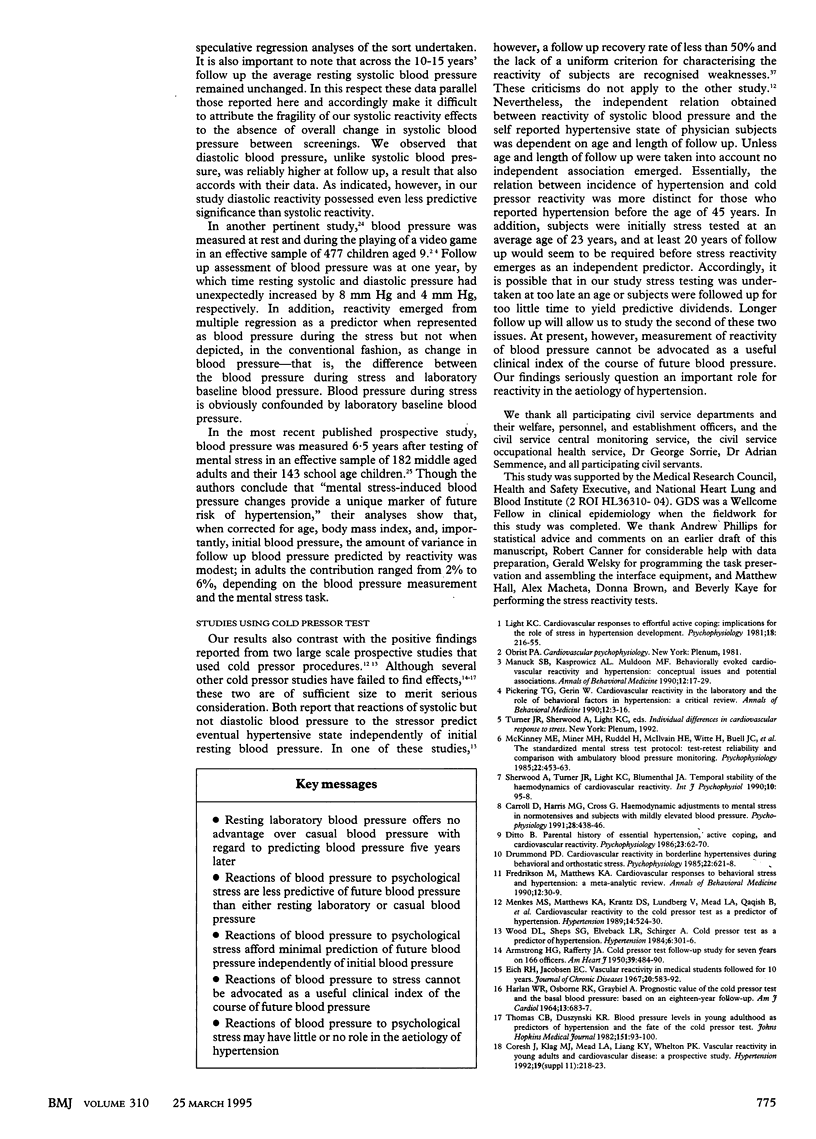Abstract
OBJECTIVE--To examine whether reactions of blood pressure to psychological stress predict future blood pressure. DESIGN--Blood pressure was recorded at a medical screening examination after which pressor reactions to a psychological stress task were determined. Follow up measurement of blood pressure was undertaken, on average, 4.9 years later. SETTING--20 civil service departments in London. SUBJECTS--1003 male civil servants aged between 35 and 55 years at entry to the study. MAIN OUTCOME MEASURE--Blood pressure at follow up screening. RESULTS--Reactions of systolic blood pressure to stress correlated positively with systolic blood pressure at follow up screening (r = 0.22, P < 0.01). The dominant correlate of follow up blood pressure was blood pressure at initial screening (r = 0.60; P < 0.01 between initial and follow up systolic blood pressure; r = 0.59, P < 0.01 between initial and follow up diastolic blood pressure). Stepwise multiple regression analysis indicated that reactions to the stressor provided minimal prediction of follow up blood pressure over and above that afforded by blood pressure at initial screening. In the case of follow up systolic blood pressure, systolic reactions to stress accounted for only 1% of follow up variance; systolic blood pressure at initial screening accounted for 34%. With regard to diastolic blood pressure at follow up, the independent contribution from diastolic reactions to stress was less than 1%. CONCLUSION--Pressor reactions to psychological stress provide minimal independent prediction of blood pressure at follow up. Measurement of reactivity is not a useful clinical index of the course of future blood pressure.
Full text
PDF





Selected References
These references are in PubMed. This may not be the complete list of references from this article.
- ARMSTRONG H. G., RAFFERTY J. A. Cold pressor test follow-up study for seven years on 166 officers. Am Heart J. 1950 Apr;39(4):484–490. doi: 10.1016/0002-8703(50)90246-8. [DOI] [PubMed] [Google Scholar]
- Borghi C., Costa F. V., Boschi S., Mussi A., Ambrosioni E. Predictors of stable hypertension in young borderline subjects: a five-year follow-up study. J Cardiovasc Pharmacol. 1986;8 (Suppl 5):S138–S141. doi: 10.1097/00005344-198608005-00030. [DOI] [PubMed] [Google Scholar]
- Carroll D., Harris M. G., Cross G. Haemodynamic adjustments to mental stress in normotensives and subjects with mildly elevated blood pressure. Psychophysiology. 1991 Jul;28(4):438–446. doi: 10.1111/j.1469-8986.1991.tb00728.x. [DOI] [PubMed] [Google Scholar]
- Carroll D., Turner J. R., Hellawell J. C. Heart rate and oxygen consumption during active psychological challenge: the effects of level of difficulty. Psychophysiology. 1986 Mar;23(2):174–181. doi: 10.1111/j.1469-8986.1986.tb00613.x. [DOI] [PubMed] [Google Scholar]
- Ditto B. Parental history of essential hypertension, active coping, and cardiovascular reactivity. Psychophysiology. 1986 Jan;23(1):62–70. doi: 10.1111/j.1469-8986.1986.tb00596.x. [DOI] [PubMed] [Google Scholar]
- Drummond P. D. Cardiovascular reactivity in borderline hypertensives during behavioural and orthostatic stress. Psychophysiology. 1985 Nov;22(6):621–628. doi: 10.1111/j.1469-8986.1985.tb01656.x. [DOI] [PubMed] [Google Scholar]
- Eich R. H., Jacobsen E. C. Vascular reactivity in medical students followed for 10 yr. J Chronic Dis. 1967 Aug;20(8):583–592. doi: 10.1016/0021-9681(67)90035-5. [DOI] [PubMed] [Google Scholar]
- Falkner B., Kushner H., Onesti G., Angelakos E. T. Cardiovascular characteristics in adolescents who develop essential hypertension. Hypertension. 1981 Sep-Oct;3(5):521–527. doi: 10.1161/01.hyp.3.5.521. [DOI] [PubMed] [Google Scholar]
- Fredrikson M., Dimberg U., Frisk-Holmberg M., Ström G. Haemodynamic and electrodermal correlates of psychogenic stimuli in hypertensive and normotensive subjects. Biol Psychol. 1982 Aug-Sep;15(1-2):63–73. doi: 10.1016/0301-0511(82)90031-x. [DOI] [PubMed] [Google Scholar]
- HARLAN W. R., Jr, OSBORNE R. K., GRAYBIEL A. PROGNOSTIC VALUE OF THE COLD PRESSOR TEST AND THE BASAL BLOOD PRESSURE. BASED ON AN EIGHTEEN-YEAR FOLLOW-UP STUDY. Am J Cardiol. 1964 May;13:683–687. doi: 10.1016/0002-9149(64)90205-x. [DOI] [PubMed] [Google Scholar]
- Hayes R. J. Methods for assessing whether change depends on initial value. Stat Med. 1988 Sep;7(9):915–927. doi: 10.1002/sim.4780070903. [DOI] [PubMed] [Google Scholar]
- Keys A., Taylor H. L., Blackburn H., Brozek J., Anderson J. T., Simonson E. Mortality and coronary heart disease among men studied for 23 years. Arch Intern Med. 1971 Aug;128(2):201–214. doi: 10.1001/archinte.1971.00310200037002. [DOI] [PubMed] [Google Scholar]
- Light K. C., Dolan C. A., Davis M. R., Sherwood A. Cardiovascular responses to an active coping challenge as predictors of blood pressure patterns 10 to 15 years later. Psychosom Med. 1992 Mar-Apr;54(2):217–230. doi: 10.1097/00006842-199203000-00007. [DOI] [PubMed] [Google Scholar]
- Light K. C. Young Psychophysiologist Award address, 1980. Cardiovascular responses to effortful active coping: implications for the role of stress in hypertension development. Psychophysiology. 1981 May;18(3):216–225. doi: 10.1111/j.1469-8986.1981.tb03021.x. [DOI] [PubMed] [Google Scholar]
- Llabre M. M., Spitzer S. B., Saab P. G., Ironson G. H., Schneiderman N. The reliability and specificity of delta versus residualized change as measures of cardiovascular reactivity to behavioral challenges. Psychophysiology. 1991 Nov;28(6):701–711. doi: 10.1111/j.1469-8986.1991.tb01017.x. [DOI] [PubMed] [Google Scholar]
- Marmot M. G., Smith G. D., Stansfeld S., Patel C., North F., Head J., White I., Brunner E., Feeney A. Health inequalities among British civil servants: the Whitehall II study. Lancet. 1991 Jun 8;337(8754):1387–1393. doi: 10.1016/0140-6736(91)93068-k. [DOI] [PubMed] [Google Scholar]
- Matthews K. A., Woodall K. L., Allen M. T. Cardiovascular reactivity to stress predicts future blood pressure status. Hypertension. 1993 Oct;22(4):479–485. doi: 10.1161/01.hyp.22.4.479. [DOI] [PubMed] [Google Scholar]
- McKinney M. E., Miner M. H., Rüddel H., McIlvain H. E., Witte H., Buell J. C., Eliot R. S., Grant L. B. The standardized mental stress test protocol: test-retest reliability and comparison with ambulatory blood pressure monitoring. Psychophysiology. 1985 Jul;22(4):453–463. doi: 10.1111/j.1469-8986.1985.tb01632.x. [DOI] [PubMed] [Google Scholar]
- Menkes M. S., Matthews K. A., Krantz D. S., Lundberg U., Mead L. A., Qaqish B., Liang K. Y., Thomas C. B., Pearson T. A. Cardiovascular reactivity to the cold pressor test as a predictor of hypertension. Hypertension. 1989 Nov;14(5):524–530. doi: 10.1161/01.hyp.14.5.524. [DOI] [PubMed] [Google Scholar]
- Murphy J. K., Alpert B. S., Walker S. S., Willey E. S. Children's cardiovascular reactivity: stability of racial differences and relation to subsequent blood pressure over a one-year period. Psychophysiology. 1991 Jul;28(4):447–457. doi: 10.1111/j.1469-8986.1991.tb00730.x. [DOI] [PubMed] [Google Scholar]
- OLDHAM P. D. A note on the analysis of repeated measurements of the same subjects. J Chronic Dis. 1962 Oct;15:969–977. doi: 10.1016/0021-9681(62)90116-9. [DOI] [PubMed] [Google Scholar]
- Parati G., Pomidossi G., Casadei R., Ravogli A., Groppelli A., Cesana B., Mancia G. Comparison of the cardiovascular effects of different laboratory stressors and their relationship with blood pressure variability. J Hypertens. 1988 Jun;6(6):481–488. doi: 10.1097/00004872-198806000-00008. [DOI] [PubMed] [Google Scholar]
- Pickering T. G. Challenge response predictors. General principles. Am J Hypertens. 1991 Nov;4(11):611S–614S. doi: 10.1093/ajh/4.11s.611s. [DOI] [PubMed] [Google Scholar]
- Rogers S., Smith G. D., Doyle W. Field evaluation of the Copal UA-231 automatic sphygmomanometer. J Epidemiol Community Health. 1988 Dec;42(4):321–324. doi: 10.1136/jech.42.4.321. [DOI] [PMC free article] [PubMed] [Google Scholar]
- Sherwood A., Turner J. R., Light K. C., Blumenthal J. A. Temporal stability of the hemodynamics of cardiovascular reactivity. Int J Psychophysiol. 1990 Nov;10(1):95–98. doi: 10.1016/0167-8760(90)90050-n. [DOI] [PubMed] [Google Scholar]
- Thomas C. B., Duszynski K. R. Blood pressure levels in young adulthood as predictors of hypertension and the fate of the cold pressor test. Johns Hopkins Med J. 1982 Sep;151(3):93–100. [PubMed] [Google Scholar]
- Wood D. L., Sheps S. G., Elveback L. R., Schirger A. Cold pressor test as a predictor of hypertension. Hypertension. 1984 May-Jun;6(3):301–306. doi: 10.1161/01.hyp.6.3.301. [DOI] [PubMed] [Google Scholar]


